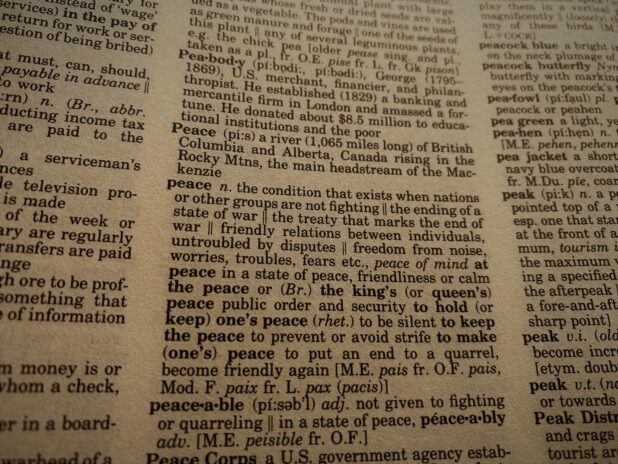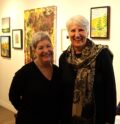Commentary
Turtles, butterflies, and common ground
October 10, 2023

By Nate Smelle
BACK IN EARLY September, the Canadian Peace Museum announced their first Stories of Peace Award contest. In order to win this award, participants were asked to produce and share a short video which answers one seemingly simple question: “What does peace mean to you?”
Since learning of the award, I have been thinking about this question, and of course how I would personally define peace. To begin my contemplation of peace and what it means to me, I first looked up its definition. According to the Websters Dictionary, “Peace is the condition that exists when nations or other groups are not fighting; the ending of a state of war; the treaty that marks the end of war; friendly relations between individuals, untroubled by disputes;
Freedom from noise, worries, troubles, fears, etc.; peace of mind; at peace in a state of peace, friendliness, or calm; the King or Queen’s peace as public order and security; to hold one’s peace; to be silent, to keep the peace, to prevent or avoid strife to make one’s peace; to put an end to a quarrel, and become friendly again.”
Doing my best to absorb this information I went for a walk in the forest to let it sink in. Sitting down under a tree and reading the definition of piece, I had jotted down on a scrap of paper. I noticed that the word peace, at least our commonly accepted understanding of the word, was ultimately dependent upon the absence of war or conflict.
Taking a break from thinking to watch the birds darting in and out of the canopy above, I could feel the changing of the seasons permeating my bones. Beyond the treetops I could hear the honking of Canadian Geese as they set out on their long journey south to soak in the sun. In the carpet of pine needles in front and beneath me a rich web of life is thriving sustainably in its harmonious agreement.
Losing myself in the moment of observation, I snapped out of my trance when I realized that for me, peace is the state of harmony I was witnessing in the forest. Admiring its never ending beauty, I reflected further on how this relatively peaceful state of co-existence was achieved over time. I thought of how species such as turtles and butterflies, with their hundreds of millions of years of evolutionary experience have attained such longevity. Could it be possible for us humans to learn from the way of life these wonders of nature embrace?
By no means is nature a world full of sunshine and lollipops. As anyone who has spent a significant amount of time observing wildlife knows, the natural world is full of fear and violence. Nonetheless, in all of nature we are the only species that wages war on such a potentially apocalyptic scale. If we are indeed the “most intelligent” species on the planet, why is it that we are so reckless and cruel when it comes to the destruction of life? Whether fighting in Ukraine, Russia, Israel, Palestine, or anywhere for that matter, in the end everyone involved — and that includes all of humanity — will lose.
Fortunately, as the Happy Christmas billboards erected on the morning of Dec. 15 courtesy of artists John Lennon and Yoko Ono reminded the world, “WAR IS OVER! If you want it.”
As of press time on Tuesday, Oct. 10 Israel was taking revenge on Palestine for its horrific deadly attack launched by Hamas on Oct. 7. Already thousands of people on both sides have been killed or injured. Hundreds of others have been taken hostage. Time and time again we have seen these types of conflicts arise. Inevitably, no matter which side ends up killing more people and taking more land than the other, the cost of war never fails to outweigh the benefits.
That is why now more than ever it is critical for us to build understanding about what peace is, and how we can attain it. But, as time has told us, there is little value in peace unless it is lasting. If we are to achieve such a long-lived, dare I say inextinguishable state of peace and harmony, such as the one enjoyed by butterflies and turtles, we must work to find our common ground.
Difficult as this may be amid the flaring fires of hate and intolerance, our shared interests exist in the earth below, the sky above and the water within. Without a fundamental care for the unconditional love and sustenance nature provides every living thing on Earth, peace is nothing more than a period of rest between wars.
The winning video in the Canadian Peace Museum’s Stories of Peace contest was created and submitted by a group of students from Bird’s Creek Public School and co-producer LeeAnne Ireland.
In the students’ video each of the young filmmakers took time to share what peace means to them. According to a handful of the young film crew of future leaders, peace is: not getting bullied; helping others; having friends; having fun; feeling safe around other people; filling someone’s bucket; watching a sunset on the lake; “no war, which means forgiveness, which means is kindness, which is peace”; “you’re outdoors, laying on the grass and you see the birds chirping and it’s very lovely and beautiful”; “It means being relaxed, not bothered, and my mind is just clear, and I don’t have any worries; and, caring, and, being kind with everyone.”
For anyone interested in showing their support for these kids’ efforts to foster a more peaceful world, the Canadian Peace Museum will hand out its first Stories of Peace Award at the Bancroft Village Playhouse from 5 p.m. to 6 p.m. on Thursday, Oct. 12. All are welcome and encouraged to join in this celebration of peace.

















